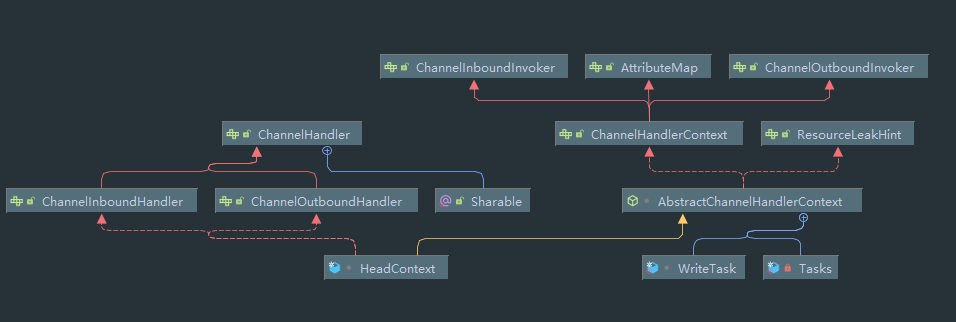ChannelPipeline.md
一个 Channel 都有一个 ChannelPipeline 。以下是 AbstractChannel 的构造方法:
protected AbstractChannel(Channel parent) {
this.parent = parent;
id = newId();
unsafe = newUnsafe();
pipeline = newChannelPipeline();
}
protected DefaultChannelPipeline newChannelPipeline() {
return new DefaultChannelPipeline(this);
}
因此,一般来说 Channel 使用的是 默认的管道 也就是 DefaultChannelPipeline ,我们来到该类的构造方法:
protected DefaultChannelPipeline(Channel channel) {
this.channel = ObjectUtil.checkNotNull(channel, "channel");
succeededFuture = new SucceededChannelFuture(channel, null);
voidPromise = new VoidChannelPromise(channel, true);
tail = new TailContext(this);
head = new HeadContext(this);
head.next = tail;
tail.prev = head;
}
可以看到它实现了一个双向链表,其中头结点是 TailContext,尾结点是 HeadContext:


头结点和尾结点同时实现了 ChannelHandler 与 ChannelHandlerContext 接口,从变量类型可以看出双向链表的类型为 ChannelHandlerContext,而我们中间传入的 Handler 只是作为 Context 的一个属性,我们可以来看看我们添加 Handler 的地方:
.handler(new ChannelInitializer<SocketChannel>() {
@Override
public void initChannel(SocketChannel ch) throws Exception {
ChannelPipeline p = ch.pipeline();
if (sslCtx != null) {
p.addLast(sslCtx.newHandler(ch.alloc(), HOST, PORT));
}
//p.addLast(new LoggingHandler(LogLevel.INFO));
p.addLast(new EchoClientHandler());
}
});
我们调用了 p.addLast 方法,参数为 ChannelHandler 类型,因此我们来到该方法:
@Override
public final ChannelPipeline addLast(ChannelHandler... handlers) {
return addLast(null, handlers);
}
@Override
public final ChannelPipeline addLast(EventExecutorGroup executor, ChannelHandler... handlers) {
ObjectUtil.checkNotNull(handlers, "handlers");
for (ChannelHandler h: handlers) {
if (h == null) {
break;
}
addLast(executor, null, h);
}
return this;
}
最终会调用 带三个参数的方法:
@Override
public final ChannelPipeline addLast(EventExecutorGroup group, String name, ChannelHandler handler) {
final AbstractChannelHandlerContext newCtx;
synchronized (this) {
checkMultiplicity(handler);
newCtx = newContext(group, filterName(name, handler), handler);
addLast0(newCtx);
// If the registered is false it means that the channel was not registered on an eventLoop yet.
// In this case we add the context to the pipeline and add a task that will call
// ChannelHandler.handlerAdded(...) once the channel is registered.
if (!registered) {
newCtx.setAddPending();
callHandlerCallbackLater(newCtx, true);
return this;
}
EventExecutor executor = newCtx.executor();
if (!executor.inEventLoop()) {
callHandlerAddedInEventLoop(newCtx, executor);
return this;
}
}
callHandlerAdded0(newCtx);
return this;
}
private AbstractChannelHandlerContext newContext(EventExecutorGroup group, String name, ChannelHandler handler) {
return new DefaultChannelHandlerContext(this, childExecutor(group), name, handler);
}
首先是同步锁,然后 newCtx = newContext(group, filterName(name, handler), handler); ,可以看出 使用 newContext 方法 将我们传入的 Handler 打包成 Context,而该方法最终是构造了一个 DefaultChannelHandlerContex:
final class DefaultChannelHandlerContext extends AbstractChannelHandlerContext {
private final ChannelHandler handler;
DefaultChannelHandlerContext(
DefaultChannelPipeline pipeline, EventExecutor executor, String name, ChannelHandler handler) {
super(pipeline, executor, name, handler.getClass());
this.handler = handler;
}
@Override
public ChannelHandler handler() {
return handler;
}
}
因此对于双向链表,其结点为 AbstractContext,而我们传入的 Handler 为其一个参数,但 HeadContext 与 TailContext 本身就实现了两个对象,其 handler 方法 返回 this 。